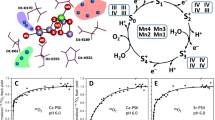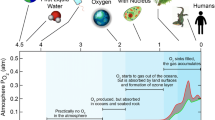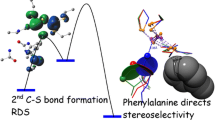Abstract
Ribulose-1,5-bisphosphate carboxylase/oxygenase (RuBisCO), the most important enzyme for the assimilation of carbon into biomass, features a well-known isotope effect with regards to the CO2 carbon atom. This kinetic isotope effect α = k 12/k 13 for the carboxylation step of the RuBisCO reaction sequence, and its microscopic origin, was investigated with the help of cluster models and quantum chemical methods [B3LYP/6-31G(d,p)]. We use a recently proposed model for the RuBisCO active site, in which a water molecule remains close to the reaction center during carboxylation of ribulose-1,5-bisphosphate [B. Kannappan, J.E. Gready, J. Am. Chem. Soc. 130 (2008), 15063]. Alternative active-site models and/or computational approaches were also tested. An isotope effect alpha for carboxylation is found, which is reasonably close to the one measured for the overall reaction, and which originates from a simple frequency shift of the bending vibration of 12CO2 compared to 13CO2. The latter is the dominant mode for the product formation at the transition state.



Similar content being viewed by others
References
Cleland WW, Andrews TJ, Gutteridge S, Hartman FC, Lorimer GH (1998) Mechanism of Rubisco: The carbamate as general base. Chem Rev 98:549–561. doi:10.1021/cr970010r
Andersson I, Backlund A (2008) Structure and function of Rubisco. Plant Phys Biochem 46:275–291. doi:10.1016/j.plaphy.2008.01.001
Andersson I (2008) Catalysis and regulation in Rubisco. J Exp Bot 59:1555–1568. doi:10.1093/jxb/ern091
Roeske CA, O’Leary MH (1984) Carbon isotope effects on the enzyme catalyzed carboxylation of ribulose bisphosphate. Biochemistry 23:6275–6284. doi:10.1021/bi00320a058
McNevin DB, Badger MR, Kane HJ, Farquhar GD (2006) Measurement of (carbon) kinetic isotope effect by Rayleigh fractionation using membrane inlet mass spectrometry for CO(2)-consuming reactions. Func Plant Biol 33:1115–1128. doi:10.1071/FP06201
Andersson I (1996) Large structures at high resolution: The 1.6 angstrom crystal structure of spinach ribulose-1,5-bisphosphate carboxylase/oxygenase complexed with 2-carboxyarabinitol bisphosphate. J Mol Biol 259:160–174. doi:10.1006/jmbi.1996.0310
Taylor TC, Andersson I (1997) Structure of a Product Complex of Spinach Ribulose-1,5-bisphosphate Carboxylase/Oxygenase. Biochemistry 36:4041–4046. doi:10.1021/bi962818w
Mizohata E, Matsumura H, Okano Y, Kumei M, Takuma H, Onodera J, Kato K, Shibata N, Inoue T, Yokota A, Kai Y (2002) Crystal structure of activated ribulose-1,5-bisphosphate carboxylase/oxygenase from green alga Chlamydomonas reinhardtii complexed with 2-carboxyarabinitol-1,5-bisphosphate. J Mol Biol 316:679–691. doi:10.1006/jmbi.2001.5381
Farquhar GD (1979) Models describing the kinetics of ribulose biphos-phate carboxylase-oxygenase. Arch Biochem Biophys 193:456–468. doi:10.1016/0003-9861(79)90052-3
Mauser H, King WA, Gready JE (2001) CO2 fixation by Rubisco: Computational dissection of the key steps of carboxylation, hydration, and C-C bond cleavage. J Am Chem Soc 123:10821–10829. doi:10.1021/ja011362p
Kannappan B, Gready JE (2008) Redefinition of Rubisco carboxylase reaction reveals origin of water for hydration and new roles for active-site residues. J Am Chem Soc 130:15063–15080. doi:10.1021/ja803464a
Witzel F, Götze J, Ebenhöh O (2010) Slow deactivation of ribulose 1,5- bisphosphate carboxylase/oxygenase elucidated by mathematical models. FEBS J 277:931–950. doi:10.1111/j.1742-4658.2009.07541.x
Tapia O, Andres J, Safont VS (1995) Transition structures in vacuo and the theory of enzyme catalysis, Rubisco’s catalytic mechanism: a paradigmatic case? J Mol Struc (THEOCHEM) 342:131–140
Safont VS, Oliva M, Andres J, Tapia O (1997) Transition structures of carbon dioxide fixation, hydration and C2 inversion for a model of Rubisco catalyzed reaction. Chem Phys Lett 278:291–296. doi:10.1016/S0009-2614(97)01001-4
Oliva M, Safont VS, Andres J, Tapia O (2001) Transition state structures and intermediates modeling carboxylation reactions catalyzed by rubisco. a quantum chemical study of the role of magnesium and its coordination sphere. J Phys Chem A 105:9243–9251. doi:10.1021/jp0113533
Tapia O, Fidder H, Safant VS, Oliva M, Andres J (2002) Enzyme catalysis: Transition structures and quantum dynamical aspects: Modeling rubisco’s oxygenation and carboxylation mechanisms. Internat J Quant Chem 88:154–166. doi:10.1002/qua.10116
Peng C, Ayala PY, Schlegel HB (1996) Using redundant internal coordinates to optimize equilibrium geometries and transition states. J Comput Chem 17:49–56. doi:10.1002/(SICI)1096-987X(19960115)17:1<49::AID-JCC5>3.0.CO;2-0
Frisch MJ, Trucks GW, Schlegel HB et al (2004) Gaussian 09, revision a.02. Gaussian, Inc, Wallingford, CT
Becke AD (1988) Density-functional exchange-energy approximation with correct asymptotic-behavior. Phys Rev A 38:3098–3100. doi:10.1103/PhysRevA.38.3098
Ditchfield R, Hehre WJ, Pople JA (1971) Self-consistent molecular orbital methods.9. Extended Gaussian-type basis for molecular orbital studies of organic molecules. J Chem Phys 54:724–728. doi:10.1063/1.1674902
Tomasi J, Mennucci B, Cammi R (2005) Quantum mechanical continuum solvation models. Chem Rev 105:2999–3093. doi:10.1021/cr9904009
Sousa SF, Fernandes PA, Ramos MJ (2007) The carboxylate shift in zinc enzymes: A computational study. J Am Chem Soc 129:1378–1385. doi:10.1021/ja067103n
Liao RZ, Yu JG, Himo F (2009) Reaction mechanism of the dinuclear zinc enzyme N-acyl-L-homoserine lactone hydrolase: A quantum chemical study. Inorg Chem 48:1442–1448. doi:10.1021/ic801531n
Liao RZ, Yu JG, Himo F (2010) Reaction mechanism of the trinuclear zinc enzyme phospholipase C: A density functional theory study. J Phys Chem B 114:2533–2540. doi:10.1021/jp910992f
Blomberg MRA, Siegbahn PEM, Babcock GT (1998) Modeling electron transfer in biochemistry: A quantum chemical study of charge separation in Rhodobacter sphaeroides and photosystem II. J Am Chem Soc 120:8812–8824. doi:10.1021/ja9805268
Scott AP, Radom L (1996) Harmonic vibrational frequencies: An evaluation of Hartree-Fock, Moller-Plesset, quadratic configuration interaction, density functional theory, and semiempirical scale factors. J Phys Chem 100:16502–16513. doi:10.1021/jp960976r
Tanaka N, Xiao Y, Lasaga AC (1996) Ab initio study on carbon Kinetic Isotope Effect (KIE) in the reaction of CH4 + Cl. J Atmosph Chem 23:37–49. doi:10.1007/BF00058703
Tcherkez GGE, Farquhar GD, Andrews TJ (2006) Despite slow catalysis and confused substrate specificity, all ribulose bisphosphate carboxylases may be nearly perfectly optimized. Proc Natl Acad Sci 103:7246–7251. doi:10.1073/pnas.0600605103
Parthiban S, de Oliveira G, Martin JML (2001) Benchmark ab initio energy profiles for the gas-phase S(N)2 reactions Y- + CH3X - > CH3Y + X- (X, Y = F, Cl, Br). Validation of hybrid DFT methods. J Phys Chem A 105:895–904. doi:10.1021/jp0031000
Zhao Y, Truhlar DG (2008) The M06 suite of density functionals for main group thermochemistry, thermochemical kinetics, noncovalent interactions, excited states, and transition elements: Two new functionals and systematic testing of four M06-class functionals and 12 other functionals. Theor Chem Acc 120:215–241. doi:10.1007/s00214-007-0310-x
Acknowledgments
We thank Dr. Tillmann Klamroth and Karl Zenichowski for constant technical and conceptional advice. J.G. was funded by the project GoFORSYS.
Author information
Authors and Affiliations
Corresponding author
Rights and permissions
About this article
Cite this article
Götze, J.P., Saalfrank, P. Quantum chemical modeling of the kinetic isotope effect of the carboxylation step in RuBisCO. J Mol Model 18, 1877–1883 (2012). https://doi.org/10.1007/s00894-011-1207-0
Received:
Accepted:
Published:
Issue Date:
DOI: https://doi.org/10.1007/s00894-011-1207-0




